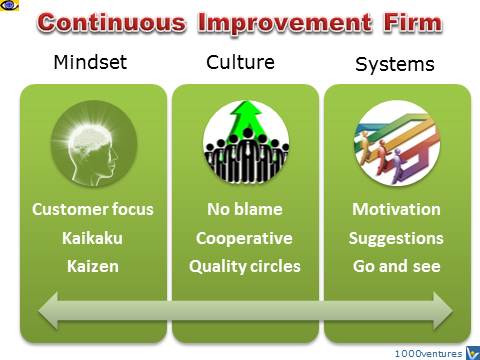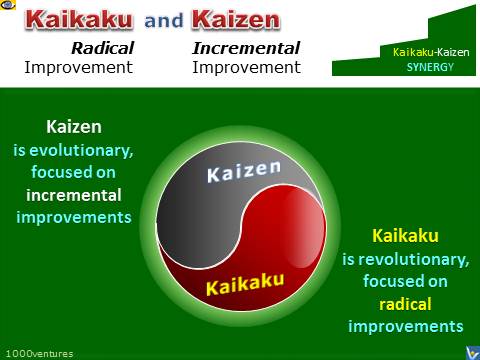|
Everything
can and should be improved ‒ look for opportunities.
|
 |
|
Continuous Improvement Firm
(CIF) Defined
CIF is a firm continuously improving on
customer value
due to
improvements in productivity
initiated by the members of the general work force. Productivity in CIF is
broadly defined to include all facets of product quality as well as output
per worker. A basic operating principle of the CIF is that improvements in
product quality often produce simultaneous reductions in costs.
The key success factor in this endogenous, incremental and continuous
technological and operational change is the organization and management of
the firm in such a way that all members are
→
motivated
to promote change and are supported in their effort to do so. What is
remarkable about the CIF is its ability to operate simultaneously in all
innovation areas:
new products,
new technology,
new organizational forms,
and new
customer relationship management.
→
Winning
Corporate Culture
→
Areas Targeted by
TQM in Japan |
|
|
3 Basic Principles of
Continuous Improvement
❶ Challenge
❷
Kaizen
❸ Go and See
>>>
Kaizen
Kaizen means
→
"improvement".
Kaizen
strategy calls for never-ending efforts for improvement involving
everyone in the organization managers and workers alike...
More
→
5 Principles
of Kaizen
Use 80/20 Analysis to
Pinpoint Improvement Areas
Business
is
wasteful.
→
80/20 Principle
asserts that 80% of what is important is
supported by 20% of effort. You can eliminate 80% of waste by spending
only 20% of what it would cost you to get rid of 100% of the waste...
More |
|
 |
|
Arguments
for Adopting the Incrementalist Perspective |
-
The future is unknown and
unknowable
-
External forces are too
powerful to be controlled by organizations or their managers
-
Managers cannot enforce
adherence to their plans
|
|
CIF
and Total
Quality Management (→
TQM)
two different perspectives of the same
phenomenon |
-
The CIF Perspective the
organization itself in all its integrity, full-blown, operating and
practicing the total quality management (TQM)
approaches
-
The TQM Perspective the
beliefs and practices required of management to bring about and
perpetuate a continuous improvement firm (CIF)
|
|
|
CIF
versus Mass Production (MP)
Firms
The ultimate
→
competitive goal of the CIF is the ability to produce consumer goods on a
custom basis for immediate delivery at costs lower than those featured by
standard MP firms. The key to achieving this
→
flexibility and lower costs
lies in the generalization of the work force...
More
5Ss
The 5S Program
defines the steps that are used to make all work spaces efficient
and productive, help people share work stations, reduce time looking
for needed tools and improve the work environment...
More
Lean Manufacturing and
Six Sigma
→
Lean Enterprise:
10 Tips
Lean manufacturing, supplemented by
Six Sigma principles, can help your company attain the goal of
continuous improvement but only when embraced as a core corporate
philosophy and rooted in the
→
corporate culture.
Management slogans often boil down to little more than platitudes in slick
consultancy packaging. But some corporate lingo stands for more than a
passing fad.10 "Lean manufacturing", a shorthand for a commitment
to eliminating waste, simplifying procedures and speeding up production, is
one such concept. Six Sigma, the quality-assurance principles that are often
integrated with lean production and
enterprise-wide process management efforts, is
another. The principles and techniques that the two terms encompass deliver
impressive bottom-line results in industrial manufacturing.
|
|
 Example of a
Truly Lean Value Chain
Example of a
Truly Lean Value Chain
 Dell
Inc. Dell
Inc.
"Constantly
question even the good stuff," advises
Michael Dell, Founder of
Dell
Inc.. "There's no
better way to improve. And don't try to cover up bad news or deny difficult
problems. Time is everything the sooner you deal with an issue, the sooner
it's resolved."...
More
→
4 WHYs
of
True Success
 Fun4Biz Suggestion System Fun4Biz Suggestion System
Innovative IT-powered
Fun4Biz suggestion system focuses on improving people.
Its all about
attitude motivation,
→
achievement, continuous growth,
transparency, recognition and involvement...
More
 AVIS AVIS
In 1963, Avis Rent A Car System, Inc. debuted a new advertising campaign
that featured a brand-new tagline "We Try Harder." For Avis, the
tagline is more than a
→
slogan
it has become part of the fabric of the
company that both reflects and influences
corporate values
→
values
and business
→
decisions...
More |
|
 GE
Work-Out GE
Work-Out
Ultimately,
the goal of the
Work-Out program was to "clean up" GE, to
make workers more productive and
processes
simpler and more clear-cut. Work-Out was also designed to reduce, and
ultimately eliminate all of the
waste hours
and energy that large organizations typically expend in performing
day-to-day operations ...
More
|
|
|
References:
-
"Competitive Manufacturing Management", John M. Nicholas
-
The 80/20 Principle, Richard Koch
-
"Wholesale
Changes", Carol Casper
-
"The Basics of
Leadership", Merlin Ricklefs
-
"Six Sigma",
Mikel Harry and Richard Schroeder
-
"Direct from Dell", Michael Dell with
Catherine Fredman
-
"TQM - Creating a Continuously Improving
Organisation", W.E. Cole and J.W. Mogab
-
"Making a Difference", Bruce Nixon
-
"Business Process
Management", Howard Smith and Peter Fingar
-
"The Lean Journey:" White Paper by Oracle Corporation
-
"Beyond Process Maturity to Process Competence,"
Andrew Spanyi
-
"Kaizen:
The Key To Japan's Competitive Success," Masaaki Imai
-
"Gemba
Kaizen: A Commonsense, Low-Cost Approach to Management," Masaaki Imai
-
"Lean
Manufacturing That Works", Bill Carreira
-
"Toyota
Production System," Taiichi Ohno
|
|